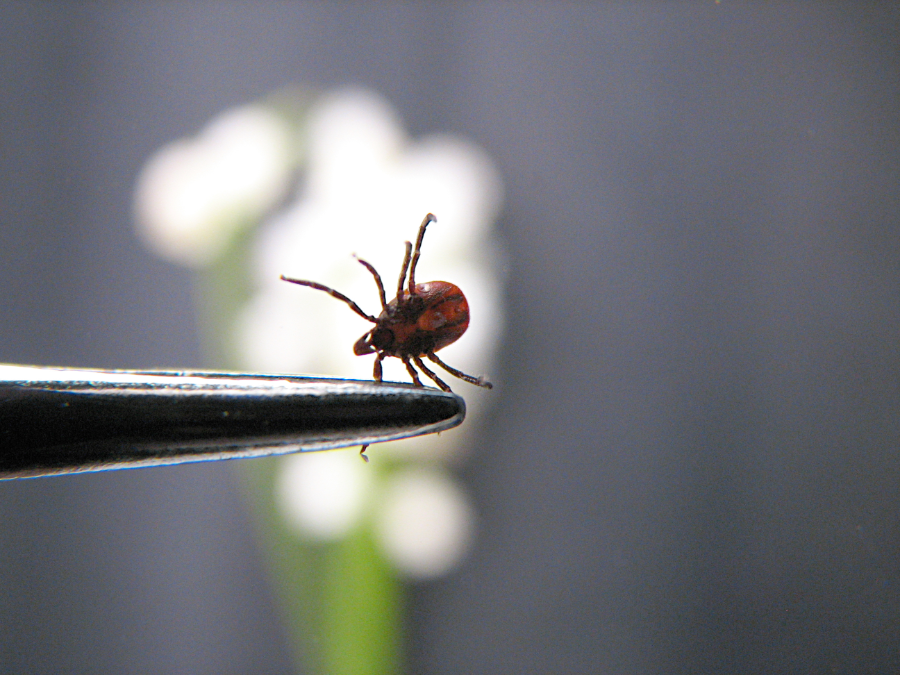How To Avoid Ticks When Hiking: 7 Useful Tips
If you have ever spent time hiking or camping in Canada, then chances are you have encountered ticks before. Those small, pesky bugs that we all try hard to avoid while hiking and make us squirm when we hear the word. Ticks are not only gross-looking, but they also carry dangerous diseases such as Lyme disease and Rocky Mountain spotted fever.
Ticks are a common concern for anyone who spends time outdoors. However, taking precautions to avoid tick bites can help you make the most of your outdoor adventures while also keeping yourself safe from any potential tick-borne illnesses. While the idea of having to search for a tick and remove it can be unsettling, being prepared with the right tools and knowledge can make all the difference in ensuring a safe and enjoyable outdoor adventure.
In this article, we will provide practical and simple tips for preventing ticks while hiking, including how to remove ticks and protect your dogs from them so that everyone can enjoy the trails.
Medical Disclaimer: We are not registered medical professionals. The following content is for informational and educational purposes only and does not substitute professional medical advice or consultations with medical professionals.
Disclaimer: This article includes affiliate links. If you click one of them, we may receive a small percentage of the sale at no extra cost to you. Thank you for your support!
Why Tick Prevention Is Important
Whether you are on the trails or exploring your own backyard, tick prevention is important to know, as there are potential health risks associated with tick bites. Ticks latch onto you during outdoor activities, particularly in wooded and grassy areas where hikers often explore. Once attached, ticks can transmit harmful pathogens through their bites.
They are known for being vectors for various diseases, the most prevalent being Lyme disease. Lyme disease is caused by the bacterium Borrelia burgdorferi and, if left untreated, can affect the heart, joints and nervous system. While not all ticks carry Lyme disease, there are over 800 species of ticks around the world, some of which can carry diseases such as anaplasmosis, babesiosis, and Rocky Mountain spotted fever. The most effective way to prevent tick bites is to follow tick prevention methods.
7 Tips To Avoid Ticks
There are a few timely and effective tick-prevention measures that can significantly reduce the risk of contracting tick-borne illnesses. By staying informed and adopting preventive techniques, you can enjoy the outdoors while lowering the potential of tick encounters.
Clothing To Wear While Hiking

When possible, minimize skin exposure while hiking by wearing long-sleeved shirts and pants. If you are hiking in the warmer months, wearing a lot of layers and longer clothing is not always ideal. If you are hiking in shorts and short-sleeved shirts, be sure to check yourself more frequently, especially if you are trekking through bush and tall grass.
Wearing light-coloured hiking gear, as opposed to black, can help you spot ticks more easily before they attach themselves to you. Ticks can be quite small and are typically black or brown in colour, making it difficult to find them on darker clothing. Wearing light-coloured clothes not only helps you spot them promptly but also reduces the chance of ticks latching onto your clothing unnoticed.
Other helpful hiking attire tips:
- Wear long socks.
- Tuck your pants into socks for an extra layer of protection, leaving ticks with limited access points.
- Gaiters can help provide extra ankle and leg protection from ticks.
- Wear closed-toe shoes, not sandals, while on the trails.
Ticks cannot jump or fly. Instead, they climb up tall pieces of grass and wait for animals or people to walk by that they can latch onto. They will then crawl around until they find exposed skin to latch onto. Choosing the right hiking attire can go a long way when it comes to avoiding ticks and ensuring they cannot reach your skin.
Use Tick Repellent Or Treated Gear
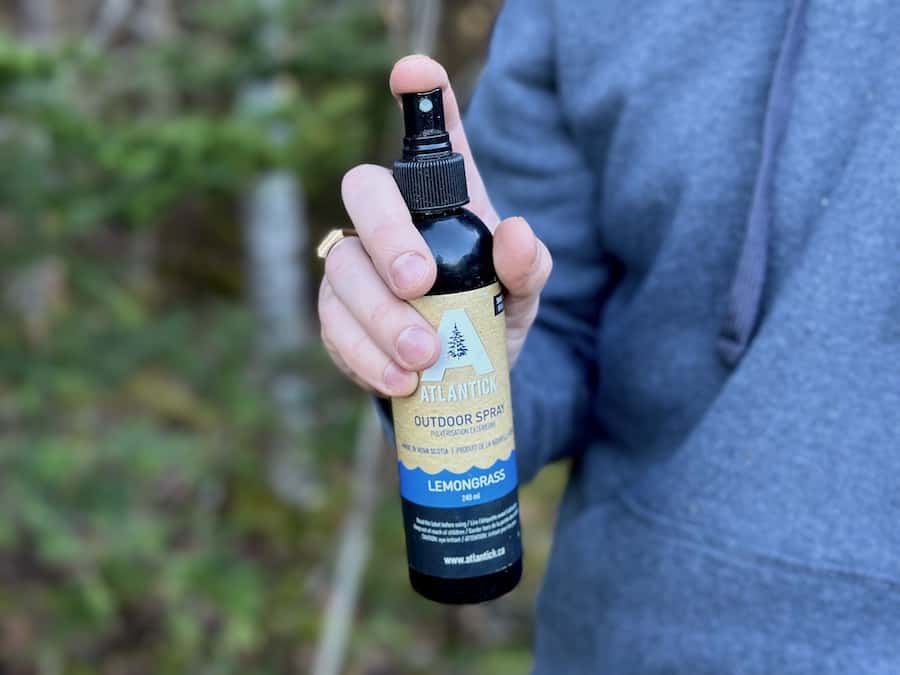
To avoid ticks during your hiking trips, you can use gear that is treated with permethrin, a synthetic insect repellent. You can either buy gear that is already treated with permethrin or purchase permethrin to treat your current gear. An application provides ongoing protection against ticks, even after multiple washes. It can be used on hiking clothes, backpacks, camping chairs, tents and more. This can be a game-changer and help give you peace of mind during your outdoor activities.
Note: In Canada, permethrin-treated clothing is approved only for people who are 16 years old or above.
There are various repellent products available that can help reduce the chances of tick bites. Insect repellents containing DEET are quite popular and can be found in most parts of the world. Be proactive in reapplying repellents, especially if you’re sweating or exposed to water.
We are fortunate enough to have a locally made all-natural tick repellent here in Nova Scotia called Atlantick. Not only does it smell incredible, but it is also safe to use on dogs. Whenever we are out hiking, we spray not only ourselves but also all our gear, including our tent, backpacks and hiking poles, as Lyme Disease is quite common where we live. We actually have stopped using DEET for tick prevention as we do not find it works nearly as well as the Atlantick spray.
Limit Time In High Tick Areas

High tick areas are places where ticks thrive and are, therefore, in abundance. One of the best ways to avoid ticks is to stay on the designated trail, where vegetation tends to be shorter. This not only helps to limit the chances of encountering ticks but also helps to protect fragile vegetation and keep the wilderness untouched.
Ticks thrive in wooded and forested environments where they can easily latch onto passing hosts, such as hikers and animals. They also love tall grass and shrubs. Areas with dense vegetation provide ideal hiding spots for ticks. It is almost impossible to avoid these areas when hiking through backcountry trails. Make sure to check yourself more frequently when going through potentially high tick areas.
Wipe Yourself Off After Going Through Tall Grass Or Bushes
As mentioned above, hiking through tall grass or bushes is sometimes inevitable when hiking. It doesn’t mean you are always going to get a tick on you when hiking in the bush. It just increases the chances. Because of this, we recommend giving yourself a quick wipe-off either with your hands or a lint roller. This helps to push off any ticks that might have crawled on you before they have time to latch.
Do A Tick Check After Hiking
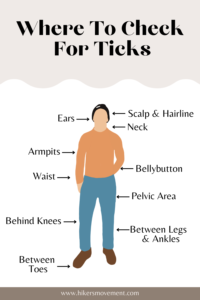
After hiking, make sure to perform a thorough full-body tick check. Finding a tick as soon as possible is key to reducing the chance of tick-borne illnesses. Depending on the type of tick and germ, it could take anywhere from a few minutes to 48 hours after it attaches and feeds for disease transmission. This is why tick checks should be done frequently, and ticks should be removed as soon as possible.
Here’s a simple step-by-step guide on how to conduct an effective tick check:
- Conduct the tick check as soon as possible after returning from your hike. The earlier you spot and remove a tick, the lower the risk of disease transmission.
- Shed your hiking gear and put them in the dryer. Ticks can latch onto clothing before reaching your skin.
- Inspect hard-to-see spots using a handheld mirror. Check your entire body, paying extra attention to:
- In and around the scalp and hairline
- In and around the ears
- Back of neck
- Under the arms and in the armpits
- In and around the navel
- Around the waist and pelvic area
- Between the legs
- Behind the knees
- Between toes
- If you have a hiking companion, perform tick checks on each other. Ticks often find their way into tricky spots that are hard to see by yourself.
- Check your hiking gear, backpacks and pets after hiking. Ticks can hitch a ride on various surfaces, so it’s best to check all your gear.
- Keep fine-tipped tweezers or a tick removal tool handy. If you find a tick, use these tools to grasp the tick’s head as close to the skin as possible.
- Do a second check later. Ticks can be sneaky, as some are as small as a freckle. Perform a secondary tick check a few hours after your initial to make sure you did not miss one.
Put Your Hiking Gear In The Dryer
If you’re worried about ticks on your clothes, simply placing them in the washer may not be enough to get rid of them, especially if you use cold water. Once you are back from your hike, we suggest that you put your clothes in the dryer first on high heat for at least 10 minutes. The high heat will kill any ticks that may be present. After that, you can wash them as usual. This should help ensure that your clothes are thoroughly cleaned and free of ticks. If your gear is wet from hiking, it may require more time in the dryer to have the same effect.
When To Hike To Avoid Ticks
Unfortunately, ticks are around all year long (yes, this includes the winter). However, they are less active during the colder months. Ticks are most active during the warmer months, typically from spring through early fall. However, these months make for some of the best hiking conditions. We are not saying to avoid hiking from spring to fall, but be aware that there is higher tick activity during these seasons, which increases the likelihood of encounters. Taking the steps to ensure proper tick prevention helps you and your loved ones avoid tick bites.
How To Remove A Tick
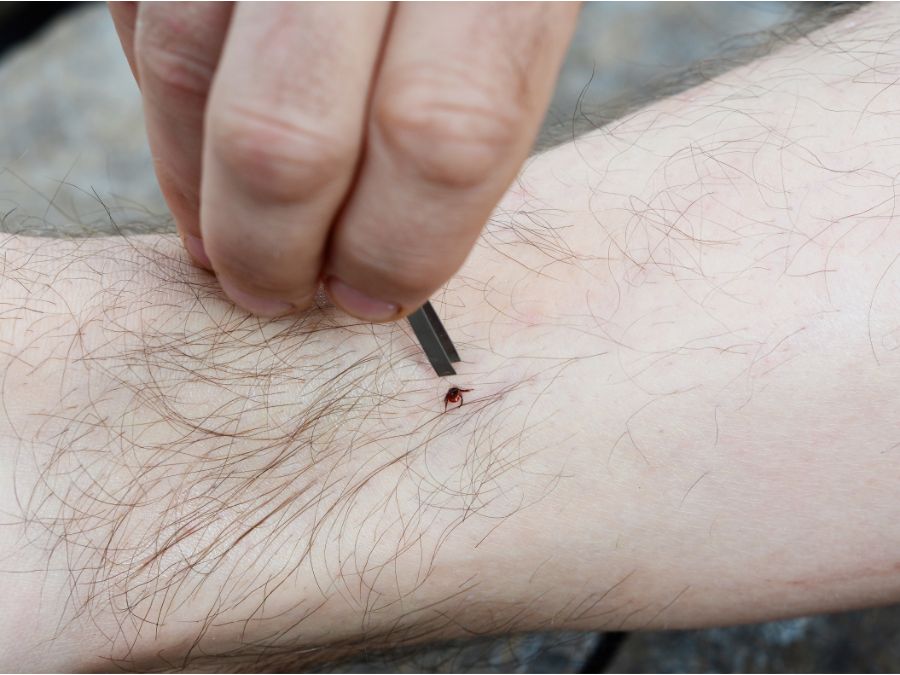
If you’ve found a tick on your body, you may feel intimidated about how to remove it. However, it is important to remove it promptly and safely to reduce the risk of disease transmission. If you feel uncomfortable doing it yourself or if the tick is deeply embedded, seek medical assistance immediately. Here are the steps you should follow to remove a tick:
First things first: do not panic and try to yank it out. This can cause the tick to break, leaving the mouth still under your skin. If this happens, please go to a medical professional to get it safely removed, as it can lead to bacterial infections.
To remove the tick, take fine-tipped tweezers or a tick removal tool and slide it between your skin and the tick’s mouth. You want to grasp the tick as close to the skin’s surface as possible, only grabbing the tick’s head, not its body. Next, pull the tick straight up and away from the skin. Do not twist it, as this may cause the mouthparts to break off and remain in the skin. It may take a couple of tries before it is safely removed.
After the tick is removed, clean the area by rubbing alcohol or soap with water. Place the tick in a small container or freezer bag and place it in the freezer until you can bring it to a healthcare provider or send it to eTick, a free tick-identifying service, to have it identified.
Over the next few days after a tick bite, monitor for any of the following symptoms.
- Erythema migrans skin rash
- Small bump or redness near the bite area
- Fatigue
- Headache
- Fever
- Joint pain
- Facial paralysis (Bell’s palsy)
- Numbness or tingles in the hands or feet
- Swollen lymph nodes
Symptoms of Lyme Disease can vary and often mimic other illnesses, making it challenging to diagnose. If you have recently been bitten by a tick and are experiencing any of the symptoms above, reach out to a medical professional immediately.
How To Protect Your Dogs From Ticks
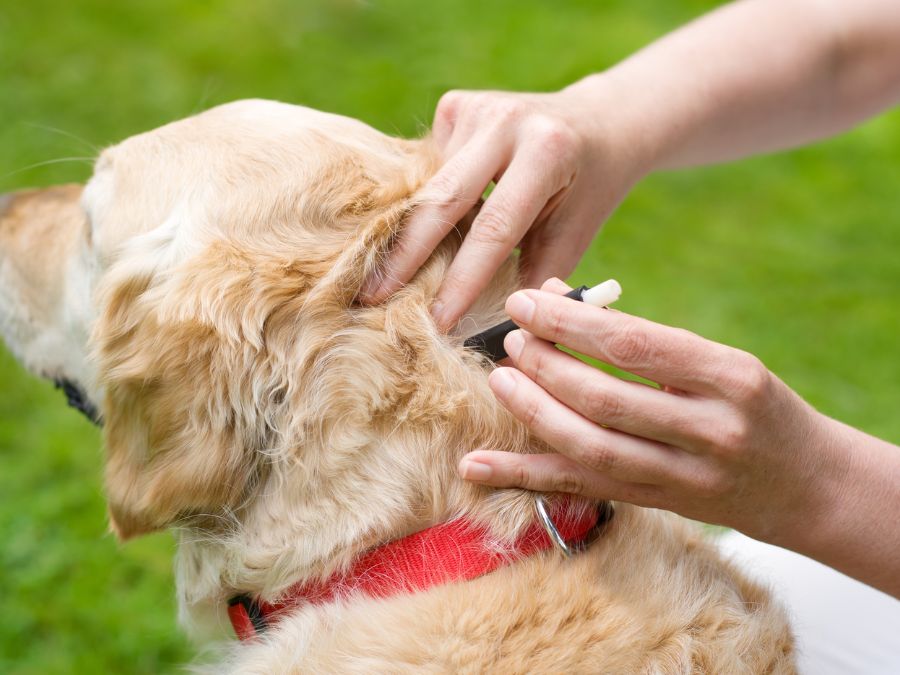
Hiking is a great activity for the whole family to enjoy, including your dog! However, when it comes to outdoor adventures, our canine companions face the same risk of encountering ticks as we do. Protecting your dogs from ticks is equally as important as protecting yourself.
If you find a tick on your dog, follow the above steps on how to remove a tick. Bring the tick to your nearest veterinary hospital and have it tested for Lyme disease.
With that being said, here are a few ways you can protect your dog from ticks and ensure you both get to enjoy the great outdoors.
Regular Tick Checks
Establish a routine for checking your dog for ticks, especially after outdoor activities. Run your fingers along your dog and check to see if you find any bumps or swollen areas along their skin. Examine it closer to see if it is a tick. Pay close attention to the ears, head, neck, and paws, particularly between the webbing between their toes.
Tick-Repellent Medications
Consult your veterinarian to choose a suitable tick-preventive medication for your dog. There are many options on the market that come in a variety of forms, such as spot-on treatments, oral medications, and tick-repellent collars. Follow your vet’s recommendations for the best protection for your dog.
Get Your Dog Vaccinated
One of the best ways to reduce the likelihood of your dog contracting Lyme disease is to have them vaccinated in combination with using tick-repellent medication. If you live in an area where Canine Lyme disease is common, it’s important to consult with your veterinarian about the vaccine.
Tick-Proof Your Yard
Tick-proofing your yard is easier said than done, and there is no guarantee it’ll keep ticks out. However, keeping your yard well-maintained by regularly mowing the grass and removing leaf litter can help limit the areas ticks like to hide in. Consider using pet-safe tick repellents in outdoor spaces frequented by your dog, or you can be like us and get chickens! They are a natural and effective form of pest control as they love to eat ticks, plus you get fresh farm eggs every day.
Protective Dog Apparel
Just like for people, you can invest in vests and clothing for your dogs that have tick-resistant treatments on them. These are great if you live in or plan to visit high-tick areas. You can also use dog-friendly tick-repellent sprays, such as Atlantick. Spray it on their collars, bandanas and rub it on their coats and paws to help prevent ticks.
Limit Exposure in Tick Hotspots:
Avoid walking your dog in tall grasses, wooded areas, or known tick-infested locations. Stick to well-maintained trails and open spaces to minimize the risk of tick encounters.
Regular Grooming Sessions
Regular grooming not only keeps your dog looking sharp but also aids in tick detection. Brushing your dog’s fur helps remove loose hair and makes it easier to spot and remove ticks.

